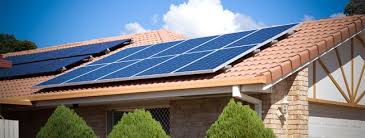Eskom, the national electricity company in South Africa, has begun using satellite technology to find homes and businesses with solar power systems that are not properly registered. This new move is part of an aggressive effort by the government to ensure that everyone using rooftop solar systems follows the rules.
In May 2025, Eskom revealed that it is now scanning the entire country using satellite images to identify unregistered Small-Scale Embedded Generation (SSEG) systems. These include solar PV (photovoltaic) panels that are installed on rooftops. The panels are easy to spot from above because they are always tilted to face the sun. By using digital maps and satellite imagery, Eskom can compare what it sees with what’s already in their registration database. If a solar system is seen but not listed, the owner may face penalties.
According to Mr. Rein Snoeck Henkemans, who is the CEO of Alumo Energy, this is a serious development and not something to ignore. He said this shows that Eskom and many local municipalities are now fully ready to enforce the law regarding unregistered solar setups.
Many South Africans rushed to install solar panels during long periods of load-shedding in recent years. But now, Snoeck Henkemans said, it is time for those users to ensure their systems are properly registered. If not, they could be disconnected from the grid or even forced to pay fines and charges for using the power system without permission.
To make things easier for people, Eskom has said it will not charge any registration fees for SSEG systems until March 2026. This means there are no application fees, no tariff adjustment fees, no connection charges, and even the cost of installing a smart meter will be free for now. However, this does not mean people can skip other steps. One important requirement is the Certificate of Compliance (CoC).
This CoC is a legal document that shows your solar power system meets the South African National Standards (SANS 10142-1) and the Occupational Health and Safety Act. Without this certificate, your system is considered illegal. Even worse, if something happens like a lightning strike and damages your solar batteries or inverters, your insurance may not pay unless you have this CoC.
Alumo Energy also listed three main checks that every solar user must do to stay out of trouble:
First, check if your system is under 100kW and whether it is connected to Eskom or the municipal grid. If so, you must register it with NERSA (National Energy Regulator of South Africa). Bigger systems above 100kW need a full licence unless they get special approval.
Second, make sure you have a valid CoC. This is not just for legal reasons. Without it, you might face issues when trying to sell your house. Banks might also refuse to give a loan or bond if they see your property has an unapproved solar setup.
Third, only allow a qualified installer to work on your solar system. The person must be registered with the Department of Employment and Labour. Even better if they are part of the Electrical Contractors Association of South Africa (ECASA). Homeowners are advised to ask for the installer’s registration card and call ECASA or the Labour Department to confirm if the person is really certified.
Some problems arise when unqualified workers, sometimes called “bakkie-brigade” installers, do the job. These people are known for cutting corners and using cheap or wrong materials. For instance, some use undersized wires or place isolators in the wrong location, which can be dangerous. Alumo Energy engineers have often seen this in the field and warn homeowners to be careful.
Eskom has also said that declaring your solar inverter as “off-grid” won’t protect you if the system ends up pushing power back into the grid, even a little. If that happens and you’re not licensed, you could face big fines. This is why grid-tied systems must be programmed with a zero-export cap, which prevents any electricity from being sent back to Eskom.
Finally, if your electricity comes from your local municipality and not directly from Eskom, you still need to check with your municipality to see if you need to register your solar setup. Some municipalities have their own rules.
South Africans are advised to use this grace period to sort out their paperwork and make sure their solar systems follow the law. According to experts, doing this now will save you money, protect your equipment, and prevent future headaches.
